Unit 3 过去分词作状语
- 格式:pptx
- 大小:3.23 MB
- 文档页数:29

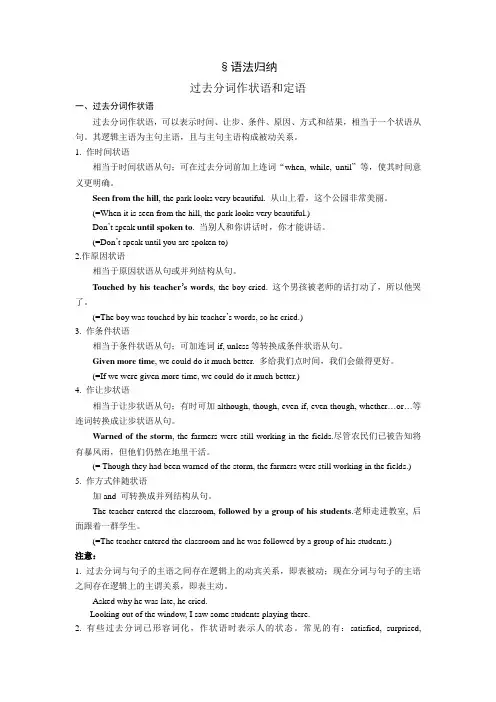
§语法归纳过去分词作状语和定语一、过去分词作状语过去分词作状语,可以表示时间、让步、条件、原因、方式和结果,相当于一个状语从句。
其逻辑主语为主句主语,且与主句主语构成被动关系。
1. 作时间状语相当于时间状语从句;可在过去分词前加上连词“when, while, until”等,使其时间意义更明确。
Seen from the hill, the park looks very beautiful. 从山上看,这个公园非常美丽。
(=When it is seen from the hill, the park looks very beautiful.)Don’t speak until spoken to. 当别人和你讲话时,你才能讲话。
(=Don’t speak until you are spoken to)2.作原因状语相当于原因状语从句或并列结构从句。
Touched by his teacher’s words, the boy cried. 这个男孩被老师的话打动了,所以他哭了。
(=The boy was touched by his teacher’s words, so he cried.)3. 作条件状语相当于条件状语从句;可加连词if, unless等转换成条件状语从句。
Given more time, we could do it much better. 多给我们点时间,我们会做得更好。
(=If we were given more time, we could do it much better.)4. 作让步状语相当于让步状语从句;有时可加although, though, even if, even though, whether…or…等连词转换成让步状语从句。
Warned of the storm, the farmers were still working in the fields.尽管农民们已被告知将有暴风雨,但他们仍然在地里干活。
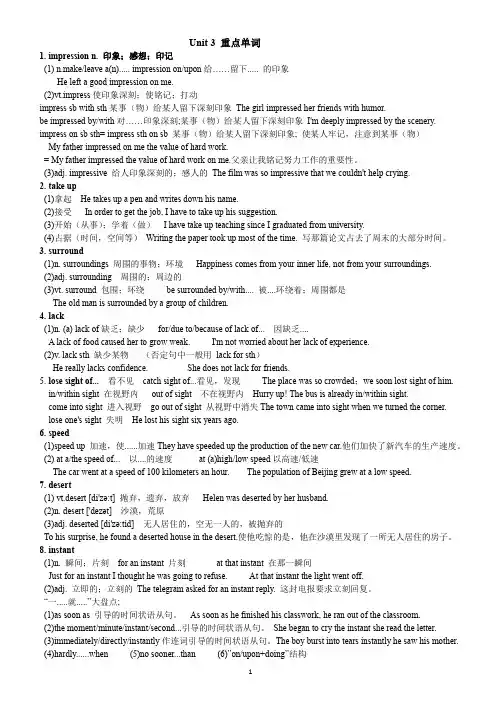
Unit 3 重点单词1. impression n. 印象;感想;印记(1) n.make/leave a(n)..... impression on/upon给……留下..... 的印象He left a good impression on me.(2)vt.impress使印象深刻;使铭记;打动impress sb with sth某事(物)给某人留下深刻印象The girl impressed her friends with humor.be impressed by/with对……印象深刻;某事(物)给某人留下深刻印象I'm deeply impressed by the scenery. impress on sb sth= impress sth on sb 某事(物)给某人留下深刻印象; 使某人牢记,注意到某事(物)My father impressed on me the value of hard work.= My father impressed the value of hard work on me.父亲让我铭记努力工作的重要性。
(3)adj. impressive 给人印象深刻的;感人的The film was so impressive that we couldn't help crying.2.take up(1)拿起He takes up a pen and writes down his name.(2)接受In order to get the job, I have to take up his suggestion.(3)开始(从事);学着(做)I have take up teaching since I graduated from university.(4)占据(时间,空间等)Writing the paper took up most of the time. 写那篇论文占去了周末的大部分时间。
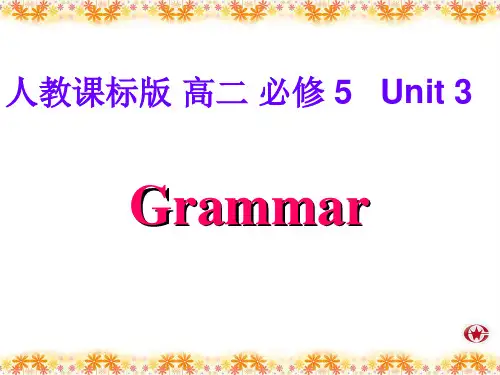

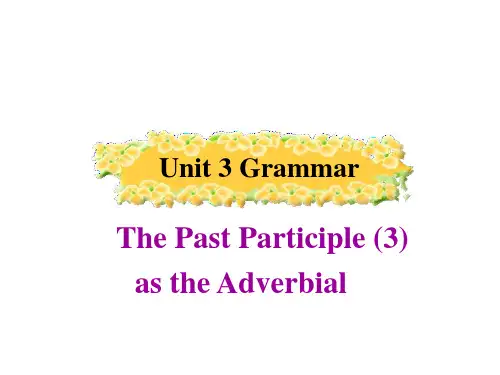

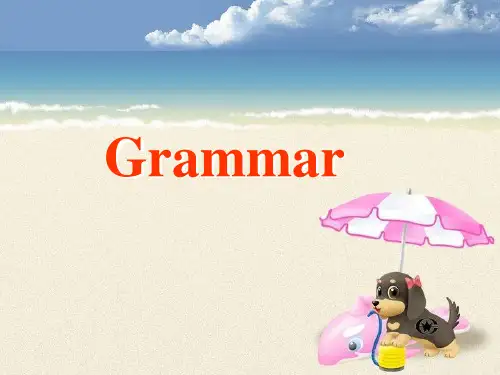
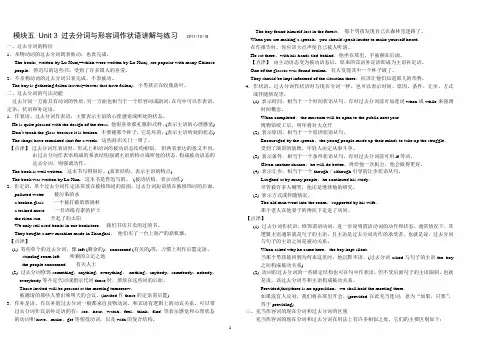
模块五Unit 3 过去分词与形容词作状语讲解与练习2011/10/18一、过去分词的特征1.及物动词的过去分词既表被动,也表完成。
The books, written by Lu Xun(=which were written by Lu Xun), are popular with many Chinese people.鲁迅写的这些书,受到了许多国人的喜爱。
2.不及物动词的过去分词只表完成,不表被动。
The boy is gathering fallen leaves(=leaves that have fallen).小男孩正在收集落叶。
二、过去分词的句法功能过去分词一方面具有动词的性质,另一方面也相当于一个形容词或副词,在句中可以作表语、定语、状语和补足语。
1.作表语。
过去分词作表语,主要表示主语的心理感觉或所处的状态。
He is quite pleased with the design of the dress.他很喜欢那礼服的式样。
(表示主语的心理感觉) Don’t touch the glass because it is broken.不要碰那个杯子,它是坏的。
(表示主语所处的状态) The shops have remained shut for a week.这些商店关门一周了。
【点津】过去分词作表语时,形式上和动词的被动语态结构相似,但两者表达的意义不同。
由过去分词作表语构成的系表结构强调主语的特点或所处的状态,构成被动语态的过去分词.则强调动作。
The book is well written.这本书写得很好。
(系表结构,表示主语的特点)The book was written by Lu Xun.这本书是鲁迅写的。
(被动结构,表示动作)2.作定语。
单个过去分词作定语常放在被修饰词的前面,过去分词短语放在被修饰词的后面。
polluted water 被污染的水a broken glass 一个被打破的玻璃杯a trained nurse 一名训练有素的护士the risen sun 升起了的太阳We only sell used books in our bookstore.我们书店只卖用过的书。
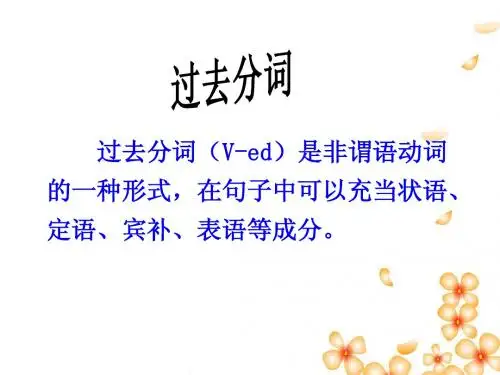
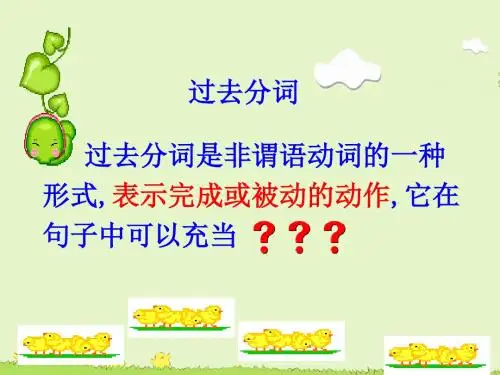
人教版高中英语同步语法精讲精练:过去分词作状语(book5unit3)本单元我们来学习过去分词作状语的用法一.过去分词在句中能作状语修饰谓语动词或整个句子。
过去分词在句中作状语1.表示时间When taken away from the mother,the baby began to cry.2.表示原因Trapped in the heavy rain,many students were late for school.3.表示条件 Given more time, We will do it better.4.表示方式The old man went upstairs,supported by his son.5.表示伴随 Followed by his students,the teacher left the classroom.6.表示结果The girl fell off her bike when crossing the road, woundedin the head.7.表示让步 Though t aught (=having been taught)many times by theteacher, some students still don’t know how to do it.二、过去分词作状语, 表示时间、原因、条件、让步时可转换为相应的状语从句(下列1-4);表示方式、结果和伴随时可转化为并列分句(下列5-7)。
如:1.When taken away from the mother,the baby began to cry.=When the baby was taken away from his mother,he/she began to cry. 2.Trapped in the heavy rain,many students were late for school.=Because/As many students were trapped in the rain, they were late for school.3. Given more time, We will do it better.=If we are given more time,We will do it better.4.Though t aught several times by the teacher,some students still don’t know how to do it.=Though some students have been taught many times,they still don’t know how to do it.5.Supporte d by his son,the old man went upstairs..=The old man was supported by his son and he went upstairs6. The girl fell off her bike when crossing the road, wounded in the head.=The girl fell off her bike when crossing the road and she was woundedin the head.7.Followed by his students,the teacher left the classroom.=The teacher left the classroom and he was followed by his students.三.现在分词与过去分词作状语的区别现在分词作状语时,与其逻辑主语之间是主动关系;而过去分词作状语时,与其逻辑主语之间则表示被动关系。
高中英语真题:高中英语Unit3Lifeinthefuture过去分词作状语试题下面这两个句子分别在第一、二单元出现过,注意观察划线部分的过去分词作什么成分。
1. But he became inspired when he thought about helping ordinary people exposed t o cholera. (P2)2. Worried about thetime available, Zhang Pingyu had made a list of the sites she wanted to see in . (P14)第1句的划线部分是过去分词短语作后置定语;第2句的划线部分是过去分词短语作状语,表示原因。
过去分词作定语的用法我们已经在第一单元学习过,本单元我们重点学习它作状语的用法。
我们先来看看下列句子或对话并注意体会黑体部分的用法。
1. Sent to zoos in and other cities, the monkeys are reported to have settled down well.2. The audience, greatly affected by his speech, all voiced su pport for the plan.3. Given a chance, I can surprise the world.4. Awarded the Nobel Prizefor Chemistry, the scientist is still working hard.5. The teacher came into the lab, followed by a group of students.6. A: What is your plan for the coming holiday?B: I will take a trip to Mountain Tai tomorrow.A: Good idea. Everything taken into consideration, Mountain Tai is the grandest mountain in .B:Sure. Located in , it attracts millions of tourists around the wo rld every year.7. A: The meeting is very important. Don’t say anything unless spoken to.B: OK. We should stick to our position. The financial situation of our company will be worse if not handled properly.【点拨】* 第1-5句的黑体部分是过去分词短语作状语,分别表示时间、原因、条件、让步和伴随。